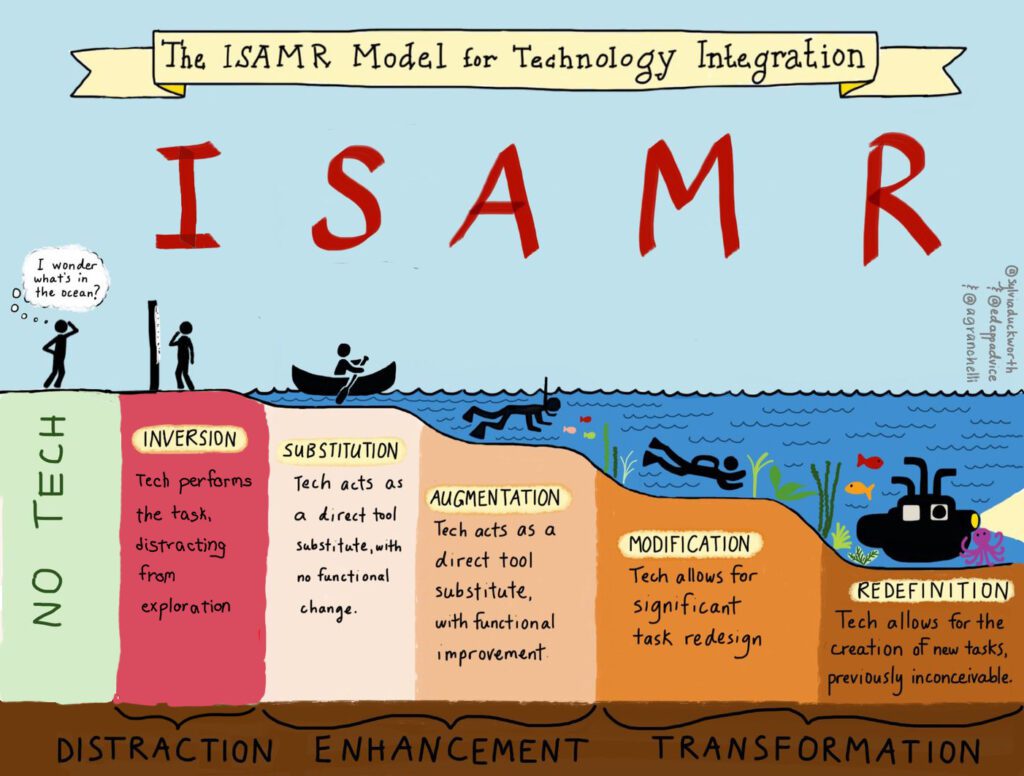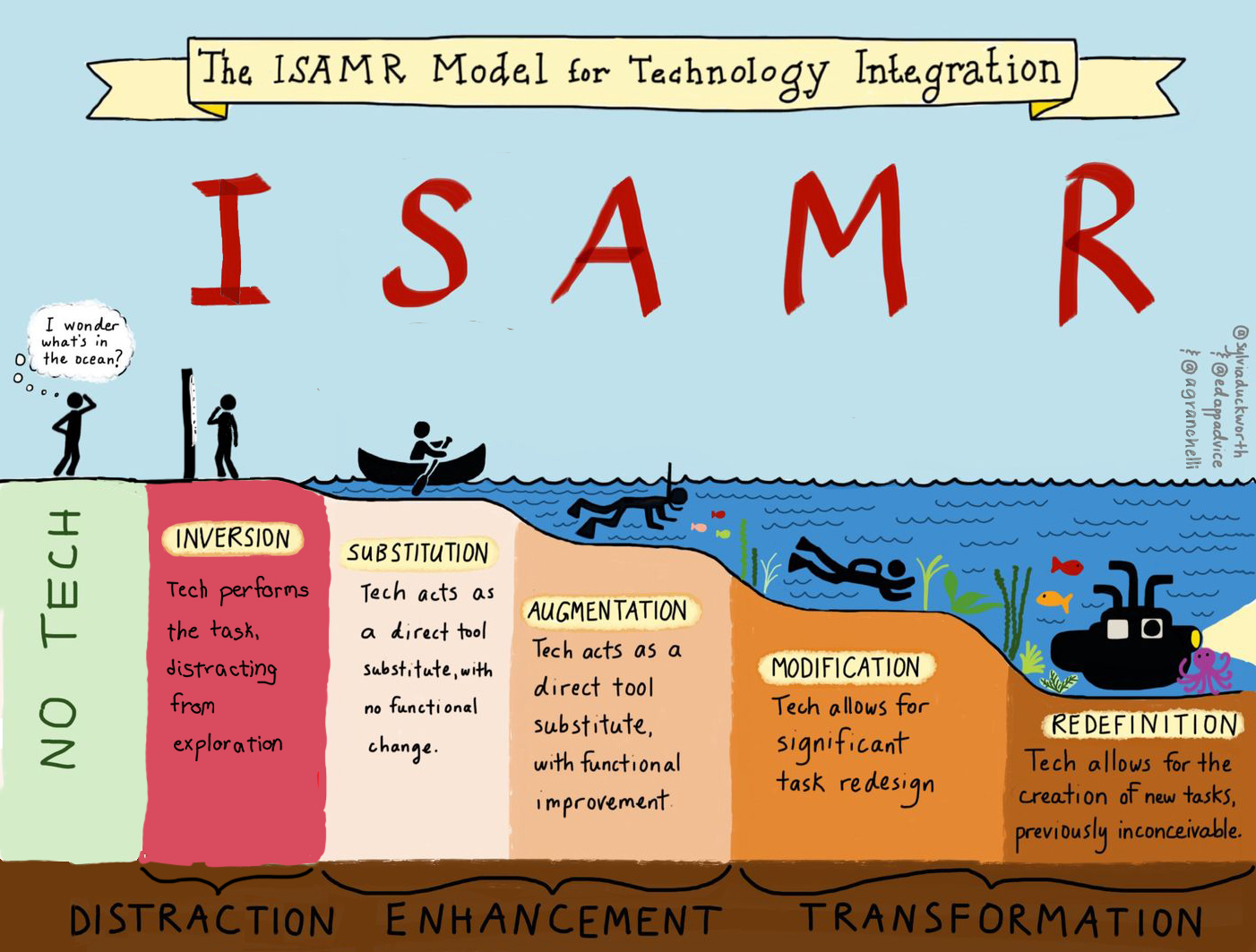My remix of Sylvia Duckworth’s (2019) infographic of SAMR
ISAMR is the combination of the SAMR and ISAR models
The SAMR model, developed by Puentedura (2016), is a guide for the effective integration of technology into teaching and learning. It offers four levels of technology integrated learning including substitution, augmentation, modification, and redefinition.
The ISAR model, developed by Bauer et al. (2025), focuses on the integration of generative artificial intelligence (GenAI) on teaching and learning and offers four stages:
- Inversion: GenAI-enhanced learning reduces cognitive processing and learning outcomes
- Substitution: GenAI-enhanced learning maintains the quality of cognitive processing and learning outcomes without the use AI but may improve efficiency
- Augmentation: GenAI provides learning support for the same quality of cognitive processing and learning outcomes as without AI
- Redefinition: “AI transforms learning tasks to foster deeper (constructive or interactive) learning” (Bauer et al., 2025, p. 9)
(Bauer et al., 2025)
This ISAR model is built upon the SAMR model and utilizes substitution, augmentation, and redefinition components. Unfortunately, Bauer et al. (2025) did not mention why they did not include the ‘M’ of the SAMR model, modification, where “tech allows for significant task redesign” (Puentedura, 2014, p. 2).
The specific cognitive functions offered at each stage of each model can be interpreted through the lens of the ICAP model (Chi & Wylie, 2014), which categorizes learner’s cognitive engagement in a continuum of four modes: interactive, constructive, active, and passive. The ICAP model hypothesizes that learning will be more effective if engagement is interactive opposed to passive (Chi & Wylie, 2014). Interactive and constructive engagement is further classified as a deep learning process while active and passive engagement as a shallow learning process (Sailer et al., 2024).
Applied to the ISAR Model:

“The ISAR model of inversion, substitution, augmentation, and redefinition effects of AI in education” (Bauer et al., 2025, p. 8)
Applied to the SAMR model:

“ICAP-inspired SAMR model” (Sailer et al., 2024, p. 4)
Technology is often utilized to perform functions previously performed by humans. It is curious that a term such as inversion has not become popular sooner in the field of educational technology. Reference books inverted the need for memorization, calculators the act of simple arithmetic, and spellcheckers the process of editing. With the benefit of hindsight and ample time for educational practices to self-correct, it is evident that the adoption of these technologies have given rise to previously inconceivable tasks that foster deep learning
Generative AI is clearly disruptive to education, and adding inversion as a new category offers a valuable extension to the SAMR model. This mode could be applied not only to GenAI but to educational technology more broadly, similar to the application of the SAMR model. So, why not ISAMR? I propose combining the models of SAMR and ISAR in order to introduce inversion into the broader scope of integrating technology in education. GenAI is only one component of technology and, on its own, should not be regarded as either stable or an independent actor (Suchman, 2023). It is simply an algorithm that most often enhances existing technologies, many of which have been in use for decades. We should approach the application and analysis of GenAI in education with specificity and purposefulness, grounded with a holistic perspective; an approach that considers technology as a whole.
Introducing ISAMR
- Inversion: Tech replaces functions previously performed by humans, reducing cognitive processing and learning outcomes (Bauer et al., 2025, p. 9).
- Substitution: “Tech acts as a direct tool substitute, with no functional change” (Puentedura, 2014, p. 2).
- Augmentation: “Tech acts as a direct tool substitute, with functional improvement” (Puentedura, 2014, p. 2).
- Modification: “Tech allows for significant task redesign” (Puentedura, 2014, p. 2).
- Redefinition: “Tech allows for the creation of new tasks, previously inconceivable” (Puentedura, 2014, p. 2).
Sylvia Duckworth (2019) created an excellent infographic on the SAMR model, which I have been revisiting for years. I felt it could be extended to include the concept of inversion, introduced by Bauer et al. (2025), so I adapted the image in Adobe Photoshop to incorporate this additional element. I shared the remixed infographic with Duckworth who then gave permission for it to be shared for non-commercial use.
I hope you find this infographic useful!

My remix of Sylvia Duckworth’s (2019) infographic of The SAMR Model for Technology Integration
ps. I would highly recommend you view Sylvia Duckworth’s other infographics and/or purchase her book. Visit here
References
Bauer, E., Greiff, S., Graesser, A. C., Scheiter, K., & Sailer, M. (2025). Looking Beyond the Hype: Understanding the Effects of AI on Learning. Educational Psychology Review, 37(2), 45. https://doi.org/10.1007/s10648-025-10020-8
Chi, M. T. H., & Wylie, R. (2014). The ICAP framework: Linking cognitive engagement to active learning outcomes. Educational Psychologist, 49(4), 219–243. https://doi.org/10.1080/00461 520.2014.965823
Duckworth, S. (2019). Sketchnotes for Educators. https://sites.google.com/view/sketchnotesforeducators/home
Puentedura, R. (2014). Building transformation: An introduction to the SAMR model [Blog post]. https://www.hippasus.com/rrpweblog/archives/2014/08/22/BuildingTransformation_AnIntroductionToSAMR.pdf
Puentedura, R. R. (2016). How to apply the SAMR model [Video]. Common Sense Education. YouTube. https://www.youtube.com/watch?v=ZQTx2UQQvbU
Sailer, M., Maier, R., Berger, S., Kastorff, T., & Stegmann, K. (2024). Learning activities in technology enhanced learning: A systematic review of meta-analyses and second-order meta-analysis in higher education. Learning and Individual Differences, 112, 102446. https://doi.org/10.1016/j.lindif.2024.102446
Suchman, L. (2023). The uncontroversial ‘thingness’ of AI. Big Data & Society, 10(2), 20539517231206794. https://doi.org/10.1177/20539517231206794
